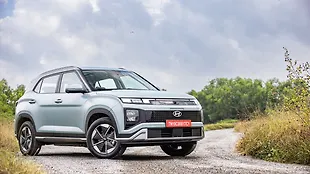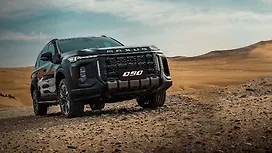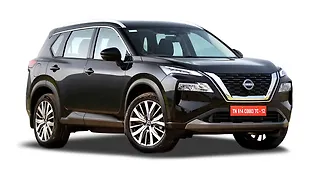What is it?
Nissan India recently showcased three upcoming products for the Indian market, of which two have been confirmed to arrive in the coming months. The first of these products will be the X-Trail, followed by the Qashqai, expected to arrive in 2023 and 2024, respectively.

The Nissan X-Trail was offered in the local market approximately eight years ago and is slated to make a comeback soon. In fact, Nissan has already started testing the model on Indian roads. The fourth-generation model was unveiled in April last year at the Auto Shanghai in China. What does the new X-Trail have in store for us? Let’s find out.
How is it on the outside?

In terms of design, the Nissan X-Trail gets the signature V-Motion grille with a black surround and horizontal slats, L-shaped LED DRLs and the main headlight cluster, a wide air dam, and a contrasting coloured skid plate up-front.

On either side, the model gets large dual-tone alloy wheels, silver roof rails, blacked-out pillars, door cladding, and the E-Power badging on the front doors.

At the rear, the Nissan X-Trail features two-piece wraparound LED tail lights, an integrated spoiler with a high-mounted stop lamp, tail-gate mounted number plate recess and X-Trail lettering, rear wiper and washer, a shark-fin antenna, and a dual-tone bumper with reflectors. The X-Trail is a departure from the budget and entry-level segment that Nissan has been aiming at in the Indian market for the past few years. To support this plan, the X-Trail, with its boxy design and extensive feature list, which could include the likes of a panoramic sunroof, is likely to hit the right spot.
How is it on the inside?

Step inside the Nissan X-Trail, and you are greeted with black upholstery and a dual-tone black and brown dashboard. Dominating the centre console is a large touchscreen infotainment system which can also be controlled via buttons placed right below it. Further, it gets automatic climate control, an engine start-stop button, USB and Type-C ports, a mobile tray, two cup holders, an electronic parking brake with auto-hold function, and an armrest with storage function on the centre console.

Elsewhere, the Nissan X-Trail receives a flat-bottom multi-function steering wheel, a fully-digital instrument cluster, height-adjustable seat belts, window curtains for the second row, Apple CarPlay and Android Auto connectivity, multiple airbags, rear parking sensors, and ABS with EBD. The unit in question missed out on a sunroof, although Nissan tells us that the India-spec model sold here will indeed get one. The SUV will also get five-seat and seven-seat configurations, a feature that none of its rivals currently offer.

The Nissan X-Trail will lock horns with the Hyundai Tucson as its chief rival. If we compare both the models in terms of features, the former misses out on a four-spoke steering wheel, power-adjustable front seats, ambient lighting, powered tail-gate with height adjustment, voice commands, OTA updates, passenger seat walk-in device, remote engine start function, terrain modes, and ADAS. On the other hand, the X-Trail gets features such as window curtains for the second row, Type-C ports, ventilated seats, and a panoramic sunroof that the Tucson doesn’t get.
What’s under the hood?

On the powertrains front, the Nissan X-Trail gets a 1.5-litre turbo-petrol motor in the 2WD format that produces 161bhp and 300Nm of torque, with a 0-100kmph run in 9.6 seconds and a top speed of 200kmph. The e-Power mill combines an electric motor and a three-cylinder petrol engine, producing a total output of 210bhp and 525Nm of torque. A 4WD system is standard. This variant can sprint from 0-100kmph in seven seconds (7.2seconds for the seven-seat version), all the way up to a top speed of 180kmph.
According to Nissan, the e-Power technology includes a battery which is integrated with the petrol engine. Unlike most mainstream hybrid cars that are driven by the ICE motor and electric motor, the e-Power system the power source is only the battery, and the ICE motor is used exclusively to charge the battery.

This technology, according to Nissan, will deliver an EV-like experience with large amounts of instantaneous torque and lower NVH as the car runs on battery power instead of the ICE motor. Another highlight would be the higher fuel economy while commuting, as the e-Power technology drives the engine at its most fuel-efficient point. What makes it stand apart from an EV is the lack of external charging (in this case, charged by the ICE motor when required)
Pricing and competition

The Nissan X-Trail is expected to arrive in the second half of 2023. The SUV could debut with a price tag of Rs 26-32 lakh (ex-showroom). To accommodate this pricing, Nissan will most likely bring the X-Trail as a CKD unit, with more than 90 per cent localisation. Once launched, the new X-Trail will rival the Hyundai Tucson, Skoda Kodiaq, Volkswagen Tiguan, Jeep Compass, and Jeep Meridian. In terms of pricing, an unconventional rival that comes to mind would be the Skoda Octavia. The Tucson currently retails around 500 units per month, and we expect the X-Trail to come with similar numbers, depending on the pricing.


























